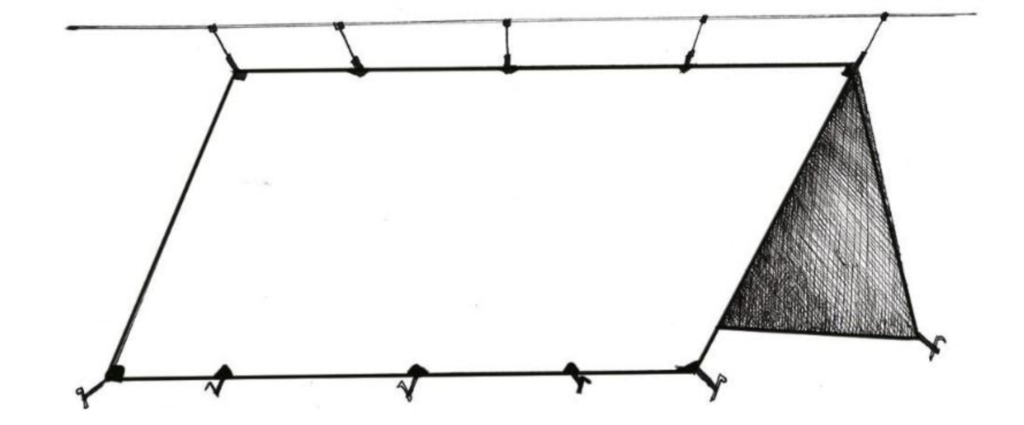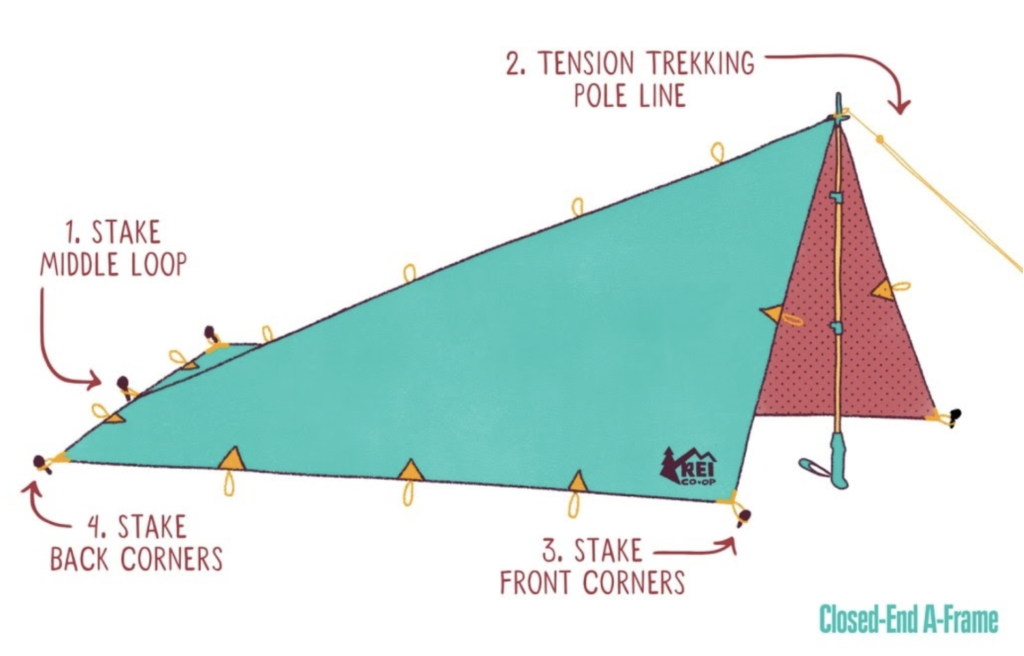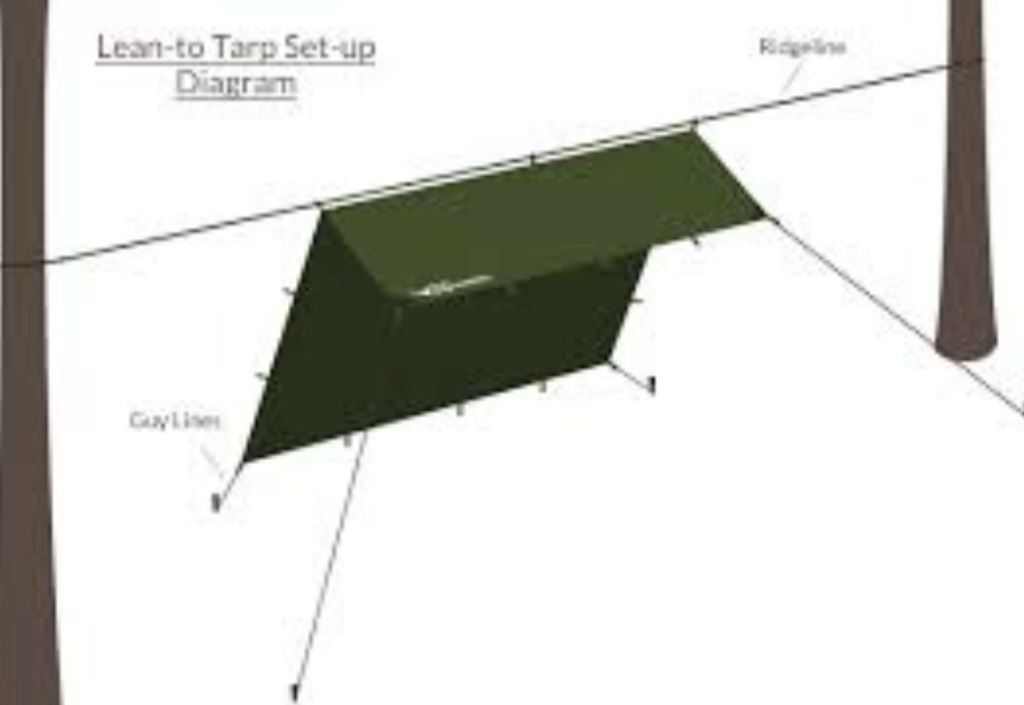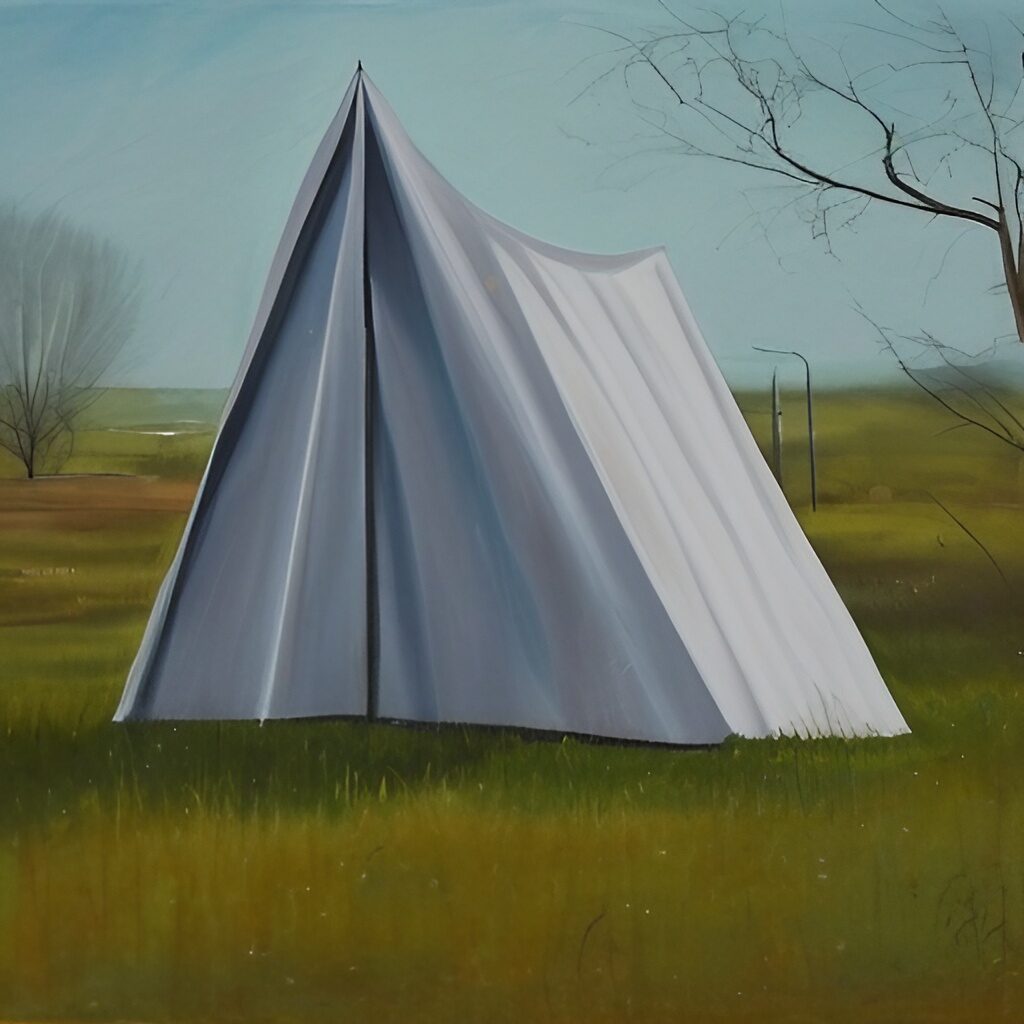
The backpacking world has its share of hotly debated topics. A noteworthy example is the quintessential question of tarp vs tent shelter.
They both have their own sets of pros and cons, so we’re going to walk through them to see if we can finally see which shelter reigns supreme.
In short, tarp shelter camping is best if you need the ultimate in lightweight and prefer flexibility in a shelter. You also need to be okay with a hyper-minimalist feel. A tent is best if you can handle an extra couple of pounds and prize privacy, added sense of security, and the feeling of four walls and a roof.
summary – Tarp vs Tent for Backpacking
| Tarp Shelter | Tent Shelter | |
| Setup Difficulty | Moderate | Low to moderate |
| Available space | Low | Moderate |
| Location | Pitch almost anywhere | Can be limited |
| Comfort | Low | Moderate |
| Weight | Extremely low weight | Moderate to heavier weight |
| Packed size | Extremely small size | Moderate to larger size |
| Weather protection | Low | Moderate to high |
| Warmth | Low | Moderate |
| Ventilation | High | Moderate |
| Durability | Low to moderate | Moderate to high |
| Versatility | High | Low to moderate |
| Price | Low | Moderate to high |
- summary – Tarp vs Tent for Backpacking
- What is Tent Camping? – Tarp vs Tent for Backpacking
- What is Tarp Shelter Camping? – Tarp vs Tent for Backpacking
- The Pros of Tent Camping – Tarp vs Tent for Backpacking
- The Cons of Tent Camping – Tarp vs Tent for Backpacking
- Different Tarp Shelter Configurations – Tarp vs Tent for Backpacking
- The Pros of Tarp Shelter Camping – Tarp vs Tent for Backpacking
- The Cons of Tarp Shelter Camping – Tarp vs Tent for Backpacking
- How to Choose Which Style Works Best for You – Tarp vs Tent for Backpacking
- Conclusion – Tarp vs Tent for Backpacking
- Frequently Asked Questions – Tarp vs Tent for Backpacking
What is Tent Camping? – Tarp vs Tent for Backpacking
Tent camping is the use of a fully enclosed shelter that’s large enough to sit up in. This “sitting up in part” is what differentiates tents from bivy sacks. (If you’re asking, “What’s a bivy?!” Then check out our comparison article on bivys vs tents for an overview!)
Tents can range in weight from just over 1 pound to 9 lbs, but they can get much heavier depending on capacity and type. We analyze a range of different tents and weights when we answer how much tents weigh?)
Plus, they come in a dizzying array of shapes, sizes, and uses. This makes them extremely versatile but decently complex.
Tents can also be used in a variety of seasons and weather conditions. Because they’re fully enclosed, they offer protection from the elements and from unwelcome crawling visitors.
What is Tarp Shelter Camping? – Tarp vs Tent for Backpacking
No, they aren’t (but technically, they can be) those blue-flappy things at Home Depot.
True camping tarps are made of much more lightweight fabric than anything at a hardware store.
This makes them insanely lightweight – we’re talking sub 1lb for some models. They pack down super small as well, some as tiny as a tennis ball.
But here’s why they’re so lightweight: tarp shelters are basically tent roofs and half walls, if that. Most tarps are really just a roof over your head to keep you dry from light rain.
Oh, and they don’t have floors, so you’re right up close to Mother Nature.
You’ll have to bring a bivy sack to protect yourself from bugs and things that would otherwise have complete liberty to crawl all over you. (Did you know some colors make bugs more likely to drop in? We share some colors that attract the fewest bugs!)
Tarp shelters can be arranged in a variety of configurations. You can stand them up as quintessential A-frame tents, for example. Or you could fashion them into lean-to’s as a barrier against the wind.
Additionally, you could string up a tarp so that it functions as a roof only. They’re often used in conjunction with hammocks since the lack of a floor or walls doesn’t matter when cocooned in a hammock.
All in all, this is a rather minimalist solution. You’re exposed to more elements since you don’t have walls to offer any protection.
As such, tarp shelters aren’t recommended for winter camping.
The Pros of Tent Camping – Tarp vs Tent for Backpacking
There are several noteworthy features that are unique to tents, making them a fierce competitor to tarp camping.
Enclosed Shelter Feel – The Pros of Tent Camping
One of the biggest selling points for tents is their home-like feeling.
No matter how tiny they are, you still have that peace of mind knowing you have four walls, a roof, and a floor enclosing you from the outside world.
Privacy and Added Sense of Security – The Pros of Tent Camping
Because you’re in a fully enclosed space, tents are a more private option. I definitely wouldn’t be able to sleep easy knowing fellow campers could be peeping at me as they walk by.
This, of course, brings with it an added sense of security. Obviously, tents aren’t robber-proof, but there’s still something to be said for feeling like you’re in a safe little nest.
Added Protection – The Pros of Tent Camping
Now, we’ve just listed a bunch of mental benefits. But not all of this is psychological.
Objectively, the enclosed space and roof protect you from the elements in a way that an open shelter doesn’t.
This protection also extends to bugs and other critters, which can’t bother you while inside your tent.
Easier Setup and More Location Options – The Pros of Tent Camping
As far as logistics go, tents are pretty easy to assemble. Not to mention, freestanding tents can be pitched anywhere, even on asphalt. (Psst… does an easy pitch sound especially appealing? We share the 16 best instant tents for every type of camper if you want to learn more!)
The freestanding feature means that you don’t have to figure out how to tie or hang a tent; it’s usually pretty self-explanatory.
Weight – The Pros of Tent Camping
Finally, some tents are so light (just over 1lb) that they’re comparable to tarp weights.
So if weight is your biggest reason for wanting a tarp shelter, definitely consider your lightweight tent options before jumping headfirst into the tarp world.
The Cons of Tent Camping – Tarp vs Tent for Backpacking
Having gone over some of their high points, tents have some unfortunate drawbacks as well.
Heavier Weights and Larger Pack Sizes (Lightweight is Expensive) – The Cons of Tent Camping
Although we just cited possible lightweight as a tent camping plus, tents can also weigh a lot more. They’re often a lot heavier than tarps, with a standard tent averaging about 4 – 7 lbs.
And sure, we did say that you can find 1lb tents out there.
But the problem with this is that they’d be significantly more expensive. Even a regular, non-ultralight tent will cost more than a tarp shelter.
Additionally, they take up a lot more room in a pack. Most of this blame can be placed on the tent poles, which can only fold down so small. The minimum size is usually around 10 – 12”.
Ventilation and Temperature Control – The Cons of Tent Camping
Another common concern with tents is their ventilation and temperature control issues.
Sometimes tents can get hot and stuffy inside since we’re sitting in there exhaling constantly. This isn’t true of all tents (thankfully!) but it’s still a real concern.
Can be Obtrusive and Inconvenient – The Cons of Tent Camping
Lastly, tents are more obtrusive if you’re trying to be stealthy.
We aren’t saying that you should go and camp somewhere illegally *ahem!*. But if – for whatever reason – you’re trying to be discreet, a large, bright orange tent will not help you blend in.
Different Tarp Shelter Configurations – Tarp vs Tent for Backpacking
Before we go over the pros and cons of tarp shelters, it might be easier to start by checking out some tarp configurations and uses.
That way, we’ll set the framework for analyzing tarps in the next section.
Keep in mind that these are just a few setup options. Lots of campers invent new tarp configurations all the time – you can too! All that matters is that you find the setup that works best for you.
So without further ado, here are three of the most common setups for tarp shelters.
A-Frame – Different Tarp Shelter Configurations

The A-Frame is a classic configuration. This was how all tents used to be shaped, even though by modern standards, it’s old fashioned and out of date.
Yet this doesn’t stop it from being the iconic tent design, the shape you see in clipart and old Boy Scout ads.
A-Frames have both the front and back ends open, with the two side walls enclosed. It provides just enough structure to feel “house-like” without having to actually be a fully enclosed tent.
The walls are really steep, which allows rain to easily roll off without pooling on the roof.
Unfortunately, because the walls are so steep, the interior can feel a little cramped.
Closed A-Frame – Different Tarp Shelter Configurations

The Closed A-Frame is – obviously- similar to the standard A-Frame in that they’re constructed with a trekking pole and a length of rope. Similarly, they both have two steep walls.
But instead of having both front and back open, the Closed A-Frame has the back shut. It tapers down to the ground.
In doing so, this shelter offers more protection from the wind and rain. Now the elements can only enter through the front rather than creating a draft from both ends.
Lean-To – Different Tarp Shelter Configurations

A Lean-to is ideal for blocking strong winds when they’re coming from one direction.
At the same time, this leaves you with your sides and front open so you can still soak in the scenery without getting blown out of your shelter.
To set up a Lean-to tarp shelter, all you do is stake down the edge of the tarp that will face into the wind. Then you fold over a small length of tarp over the ridgeline rope.
This results in a wall blocking the wind behind you. Meanwhile, your sides and front are both open for maximum airflow and scenery.
The Pros of Tarp Shelter Camping – Tarp vs Tent for Backpacking
Now that we’ve examined some of the pluses and minuses of tent shelters, let’s take a look at a few reasons why you might choose a tarp instead.
Insanely Light Weight and Small Size – The Pros of Tarp Shelter Camping
One of tarps’ strong suits is their ridiculously light weights.
Seriously, they weigh anywhere from under 1lb to just over 2 or 3 lbs. This tiny weight makes them an ideal choice for ultralight backpackers.
Because tarps eliminate walls and floors, they have less fabric to pack. So they can stuff down super small. Some are the size of a water bottle, and some go as small as a tennis ball.
No More Condensation/Overheating – The Pros of Tarp Shelter Camping
Speaking of a lack of walls, tarps have no issues with condensation buildup. They’re great at maintaining airflow too, since…ya’ know…there’s no walls to block anything in.
All this makes them wonderful for warm-weather camping, especially during the hottest days of summer. Basically, choosing a tarp shelter means you won’t slowly roast inside a fabric chamber.
Keep Your Fire Closer – The Pros of Tarp Shelter Camping
When the sun sets – or even when you’re just ready for lunch – you can build a fire much closer to your shelter than you could in a tent.
If you’re careful, you can have a small fire under your tarp. Just don’t let your fire get too tall! We review 26 camping safety tips in case you want to brush up on your knowledge.
Gets You Closer to Nature – The Pros of Tarp Shelter Camping
Another interesting thing: a lot of tarp campers swear by the open space that lets them get close to nature.
Without walls, you’ll never miss the scenic views of your surroundings. These campers speak about these experiences with a high spiritual reverence that you just can’t get in an enclosed tent.
Ability to Pitch in Harder-to-Reach Places – The Pros of Tarp Shelter Camping
If you’ve ever been frustrated by a lack of good tent camping sites, tarps make that problem nonexistent.
They’re great for when the campground is extra full, and campsites are considered prime real estate.
High Modularity and Customization – The Pros of Tarp Shelter Camping
Not only that, tarps bring a high level of modularity and customization. You can configure them in a lot of different ways.
Want a more traditional A-frame tent? Not a problem. Wind blowing strongly from one direction, but you still want your other walls open? Easy peasy! The setup options are nearly endless!
Very Affordable – The Pros of Tarp Shelter Camping
Finally, tarps bring all these benefits at a more affordable price than their tent cousins.
Now you don’t need to worry about the cost being a barrier to embarking on a camping trip. We broke down the total cost of camping and provided a budget for you so you can crunch the numbers for your next trip.
The Cons of Tarp Shelter Camping – Tarp vs Tent for Backpacking
Sure, there’s a lot of awesome things about tarps. However, there’s plenty of weaknesses that might make them unsuitable for some campers.
Reduced Protection – The Cons of Tarp Shelter Camping
The first and probably the most obvious thing: there’s drastically less protection from the elements.
That means the wind, rain, hail, or even blowing dust. If you’re caught out in more than a mild rain, well, good luck!
Thanks to this, tarp shelters are pretty much unsuited for winter camping.
The other evident concern is the lack of floors and walls.
Bugs and whatever other unpleasant crawling or flying things will be able to come and go as they please.
Now, if you’re in a hammock with mosquito netting this will be less of an issue. (Yes, these exist! Check out our piece on best hammocks with mosquito netting for bug-free camping!)
But if you’re only in an open sleeping bag, have fun with the mosquitoes!
For that reason, we strongly suggest bringing a bivy sack (one that can be enclosed) to cover up and protect yourself.
Lack of Privacy – The Cons of Tarp Shelter Camping
Next, if privacy is a concern of yours, then tarp shelters won’t help much. Any fellow campers can easily see you in your shelter.
So just be aware of that if you’re someone who feels uncomfortable with the possibility of people peeping in on you.
Can Be Difficult to Pitch – The Cons of Tarp Shelter Camping
Tarp shelters can also be difficult to pitch. Some campers mention the learning curve, saying that tarps are harder than tents when it comes to setup.
To get a feel for how to set up a tarp yourself, check out this video by REI.
Need to Be Pitched on Soft Ground – The Cons of Tarp Shelter Camping
Speaking of setup, tarps can’t be pitched on asphalt or on especially rocky ground.
Maybe you’re planning on going to a campground with asphalt campsites. You wouldn’t be able to nail your stakes into that, so…well, no shelter for you.
With freestanding tents, the stakes are optional. This isn’t so for tarps, unfortunately.
Of course, this isn’t an ironclad rule; a lot of this depends on the setup and pitch of your tarp (for example, maybe you just want to tie it up as a roof using a few trees).
How to Choose Which Style Works Best for You – Tarp vs Tent for Backpacking
Before we dive into this section, here’s an upfront disclaimer: a lot of the selection process ultimately boils down to personal preference.
But that said, there are a few situations in which one shelter will be better suited than the other.
Tarp camping might be for you if you’re an ultralight hiker or a long-distance hiker.
The minimal weight of a tarp will help you maximize your mileage. Less pack weight equals less fatigue and more endurance to crush out those extra miles.
In addition, you’ve likely got enough experience to understand that tarp camping requires a minimal mindset.
Or perhaps you’re not looking to embark on extended treks. Instead, you just might not be that paranoid about privacy.
Additionally, tarp camping makes a lot of sense for hammock owners.
Tarp shelters and hammocks tend to go hand-in-hand. You don’t have to pair a tarp with a hammock, but they can provide some protection from rain should the weather get wet.
Finally, none of these things may apply to you. Maybe you’re just a true nature nut who wants to soak in every last ounce of the outdoors!
No tent walls here, please. You just want the stunning scenery!
On the other hand, tent camping might be for you if you enjoy the comfort of having a portable home-away-from-home.
Four walls, roof, and a floor can do wonders for your mental health while in the backcountry.
It’s also well-suited for those who enjoy their privacy. It just feels nicer to have a tiny, safe corner where no one can see you.
Tent camping is a good choice if you don’t need or care about an ultralight pack. Maybe you’re a casual camper who doesn’t need to knock out long miles.
Or maybe you are a long-distance hiker who draws the line at creature comforts.
Either way, either of these options can be viable. It just depends on your situation and your choices!

Conclusion – Tarp vs Tent for Backpacking
While we may not have resolved the great tarp shelter vs tent debate, we hope we’ve at least shed a little light on it for you!
They both have great benefits as well as their own weaknesses. But perhaps now you’re feeling more equipped to decide which option is best suited to you and your trip.
Frequently Asked Questions – Tarp vs Tent for Backpacking
What are the Best Tarps to Use for a Shelter? – FAQs
Tarps should be used for additional wind protection when camping in windy conditions. Heavy-duty tarps, made of a durable material such as vinyl or polyethylene fabric, are ideal for use as a shelter. They should also be waterproof and tear-resistant for maximum protection against the elements such as wind, snow, rain, and sun.
Make sure your tarp is large enough to provide adequate coverage while remaining lightweight; a 10′ x 16′ tarp should provide adequate coverage while remaining lightweight.
Consider adding several layers of tarp underneath the main layer for added insulation; this will create an extra cushioning effect that will help to insulate you from cold drafts of air.
Furthermore, grommets or anchor points are required if you plan to use your tarp outside, as they help secure it to the ground during high winds.
What Kinds of Stores Sell Tarps? – FAQs
Tarps can be found in a wide range of stores, including hardware stores, camping supply stores, and even some department stores. Tarps are available from many online retailers in a variety of sizes, materials, and styles to suit any need.
Consider factors such as size, durability, waterproofing, and price before purchasing one; this will help you find the best tarp for your needs. Additionally, if possible, ask questions at the store before buying–they can provide additional information about their products.
Can You Build a Tarp Shelter On Top of a Tent? – FAQs
Yes, it is possible to build a tarp shelter on top of a tent.
This method provides additional protection from the elements and helps insulate the interior from cold drafts of air.
The tarp can be used to create a space between you and nature that allows for maximum ventilation, eliminates condensation buildup, and keeps mosquitos out.
When setting up your tarp shelter, make sure that it’s securely attached to the ground or walls of the tent. Additionally, keep an eye on wind conditions to ensure that the tarp does not become loose or tear in extreme weather conditions.














